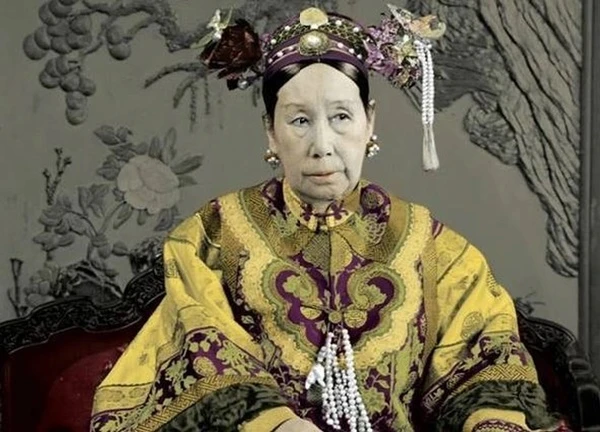Ly Tu That appeared, climbed straight to hot search because of 18s clip, 76 million people reacted strongly

3 | 1 Discuss | Share
Recently, a photo said to be of a Qing Dynasty young lady with two maids has received much attention. Her beauty is charming but there is a small detail that makes people shudder.
The Qing Dynasty, also known as the Manchu Dynasty, was the last feudal dynasty in Chinese history. Old photos taken at this time are always valuable documents that give future generations a more realistic view, different from the scenes often seen in famous movies.
In particular, a photo of three Qing Dynasty girls has attracted the attention of many people. Although the three girls are of the same age, their different identities can be clearly guessed from the way they dress. The girl in the middle sits on a chair, her clothes are clean, her face is gentle, and she wears many exquisite jewelry, making many people affirm that she is the young lady of a noble family.
In addition, people also speculate that the girl standing on the right of the photo is probably a first-class maid - a maid who is close and has a higher position. Because this girl is wearing shoes and some jewelry on her body. Finally, the girl standing on the left may be the one with the lowest status because she is completely barefoot, does not wear jewelry, and her clothes are also made of rough and wrinkled fabric.
However, what attracts the most attention is the "lotus heel" feet tightly wrapped in the young lady's small shoes. This is a symbol of the beauty and nobility of Chinese women in ancient feudal society. However, this custom also causes a lot of controversy because it is too cruel.
Chinese foot binding custom
The tiny, tightly bound feet of ancient Chinese women were given beautiful names like "lotus heels" or "lily heels." It was believed that foot binding would make women walk unsteadily, like lotus branches swaying in the wind.
It is known that foot binding in China has almost become a tradition of women in this country throughout the feudal period. Many people believe that this custom partly reflects the concepts and social prejudices of ancient Chinese people.
To have small bound feet, "three-inch lotus heels", women in the past had to endure pain for a long time. Mothers or grandmothers in the family would start binding their daughters' and granddaughters' feet when they were 2-5 years old, a time when the foot bones had not fully developed.
First, the girls’ feet were soaked in warm water mixed with herbs and animal blood. Then, the foot-binding practitioner gently massaged the feet and used force to bend the toes down, pressing them against the soles of the feet. The arch bones were broken, and the entire foot was then wrapped tightly in bandages.
The bandages would be removed periodically for washing and massaging. However, the girls’ feet would be bound even tighter after that. Not only that, the ancients would also hit the soles of the girls’ feet hard, shattering the bones. Once the bandages were re-wrapped, the girls would be forced to walk on the floor, further deforming their feet.
After 2 years, the foot will remain the same shape for the rest of its life. Common complications are swollen feet, pus discharge and even gangrene due to infection. This makes anyone shudder because it is so cruel.
According to many documents, the first person to initiate foot binding was a concubine during the Southern Tang Dynasty (937 - 975). It was the concubine's dance with her feet wrapped in silk that captivated the emperor and caused other concubines to follow suit. Gradually, this custom spread to many regions in China, to the point that girls without bound feet were looked down upon.
It is worth mentioning that noblewomen who did not bind their feet could only marry men of lower status, while poor women were more likely to be looked down upon and sold into slavery. In addition, ancient people believed that foot binding was also a method to bind women to their families.
The reason is that with painful bound feet, women will walk less, and therefore stay at home to take care of their husbands and children. In addition, focusing on the thighs and hips also makes women's figures much more attractive in the eyes of the opposite sex.
The custom of foot binding "lotus heels" is banned.
The practice lasted for more than 1,000 years and was officially banned in 1912, although it was still practiced secretly in some places. However, with the rise of controversial “female virtue†classes, foot binding has suddenly gained more supporters in recent years.
Many people have spoken out in defense of this practice on online forums, some even sharing their experiences of foot binding in chat groups and advising others to follow suit.
On the e-commerce site Xianyu, a variety of foot-binding products are also on sale, including shoes, socks, and embroidered cloths. A store specializing in traditional embroidery items is selling custom-sized foot-binding shoes for 1,500 yuan (about 5.1 million VND).
According to the deputy director of the Southwest University Museum, the foot-binding shoes should be treated as historical artifacts and put into museums for display purposes instead of being sold for profit. He also warned that it could have a negative impact on young people who are looking to revive the practice for aesthetic purposes.
"Living ghost" snatches chicken from homeowner's hand, unexpected ending, netizens are fed up  Bình Minh12:53:20 17/08/2024Recently, a clip went viral on social media, recording the scene of a girl in black recklessly snatching a ghost, causing a stir among netizens. Many people expressed their disgust at the character's actions.
Bình Minh12:53:20 17/08/2024Recently, a clip went viral on social media, recording the scene of a girl in black recklessly snatching a ghost, causing a stir among netizens. Many people expressed their disgust at the character's actions.

3 | 1 Discuss | Share

3 | 1 Discuss | Share

4 | 1 Discuss | Share

1 | 1 Discuss | Share

2 | 1 Discuss | Share

3 | 1 Discuss | Share

1 | 1 Discuss | Share

4 | 1 Discuss | Share

3 | 1 Discuss | Share

2 | 1 Discuss | Share

4 | 1 Discuss | Share

5 | 1 Discuss | Share










1 | 1 Discuss | Report